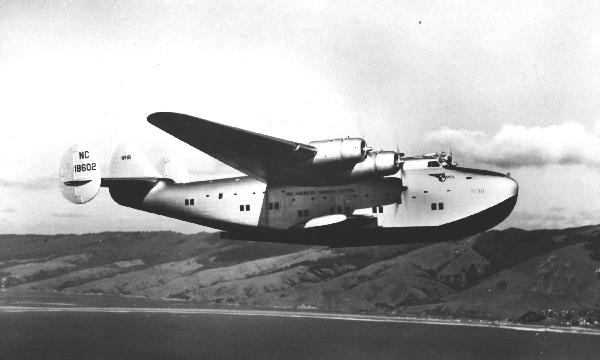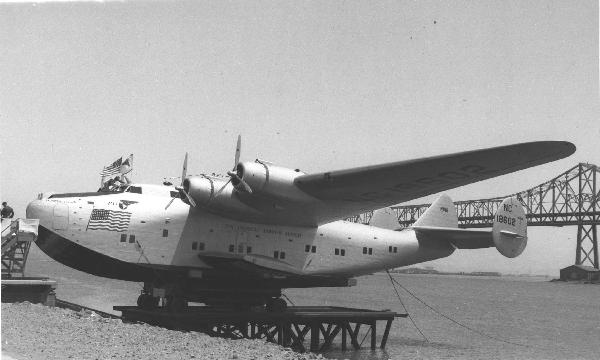
|
 |
Boeing 314 Clipper |
 |
 |
 |
 |
 |
|---|---|---|---|---|---|---|---|
 |
 |
 |
 |
 |
|||
 |
||
|
The Yankee Clipper project dates back to 1935, with the start of a series of negotiations between Pan American World Airways and Boeing for the production of a flying-boat capable of guaranteeing transatlantic passenger flights with a high degree of safety, comfort and speed.1 On July 21, 1936, Pan American signed a contract for six Model 314s, the first of which made its initial sea run on Puget Sound on May 31, 1938, and made its inaugural flight on June 7, 1938. 2 When it made its appearance, the Model 314 flying-boat was the largest civil aircraft in service. It outstripped all rivals in size, with twice the size of the Sikorsky S-42 and outweighed the Martin M-130 China Clipper by 15 tons.3 The 14-cylinder double-row Wright Cyclones were the first to use 100-octane fuel. The Boeing 314 weighed 40 tons and the first block ordered cost $550,000 per aircraft. |
| It had a central hull and adopted the wing and engine assembly of the experimental Boeing XB-15 heavy bomber.4 In the place of the traditional floating stabilizers at the wingtips, sponsons mounted on the sides of the hull were used. The sponsons were based on the formula developed by the German engineer Claude Dornier and incorporated into such aircraft as the Dornier Do X and Dornier Do 18. The sponsons also contained fuel tanks, the capacity of which (together with those situated in the wings) totaled almost 3,525 gallons (16,000 liters). |
 |
|---|
|
Mechanics performing maintenance repairs on the California Clipper. The number on the center vertical stabilizer is No 18 and the number on the left hand vertical stabilizer is NC 18602. |
|
At first, Boeing had problems with the single vertical stabilizer which resulted in inadequate directional control. It tried a twin-tail arrangement and finally settled on the three fins which became a feature of the design.
In the spacious fuselage, there was ample room for 74 daytime passengers or 40 passengers in reclining seats for long night-flights.
On May 20, 1939, Pan American inaugurated the first transatlantic mail service. Under the command of Captain A. E. LaPorte, almost a ton of mail was carried from Port Washington to Marseilles, via the Azores and Lisbon in 29 hours. The same aircraft, commanded by Captain Harold Gray, opened the northern mail service to Southampton on June 24, 1939. On June 28 ,1939, Pan American inaugurated the first regular passenger service from New York to Southampton, via Newfoundland. Under the command of Captain R.O.D. Sullivan, the "Dixie Clipper" carried the first scheduled passengers across the North Atlantic. Twenty-two privileged passengers had the option of paying $375 one-way (about $4,000 in today's money) or $675 return (about $7,000 or $8,000, or twice Concorde levels). The Yankee Clipper opened the northern passenger route on July 8, 1939, carrying 17 passengers at the same fare. Today, the North Atlantic route is still the most prestigious of all today despite the immense growth of the airlines. The golden age of the commercial flying-boats was abruptly interrupted by the outbreak of the Second World War in Europe on September 3, 1939. The war curtailed Pan American's opportunity to build on its success and the northern transatlantic route was abandoned after only three months on October 3, 1939. With the success of the Boeing 314, Pan American ordered another six aircraft with the designation Boeing 314A. The 314A was considerably improved—it had a carrying capacity of 77 daytime passengers, increased engine power, and increased fuel capacity of nearly 1,000 gallons (4,500 liters). The first Boeing 314A flew as a prototype on March 20, 1941, but with WW II in full swing, only half the order went to Pan American. Three models were bought by the British government and allotted to BOAC for use as transport aircraft. |
 |
|---|
|
Aircraft shown is the Atlantic Clipper. The number on the left hand vertical stabilizer is NC 18604. |
|
Subsequently, Boeing 314s continued flying all over the globe, flying mostly the Atlantic crossing by the central route, or via Brazil and West Africa. They made many important flights during the war, in support of military operations as far afield as Southeast Asia. The Boeing 314s were well known for the fact that they carried Winston Churchill on his intercontinental journeys and survived the war to be returned to the United States in 1948.
The career of the Boeing 314, five of which were purchased by the USAAF and the US Navy, was also a lengthy one. Apart from three which were destroyed in February 1943, November 1945 and October 1947, others remained with Pan American. With the progress made in developing long-range landplanes during WW II, the last Boeing 314 was retired from Pan American World Airways in 1946. They were then used by various small charter companies and not withdrawn from service until 1950. |
| Boeing 314 Aircraft Operated by Pan American World Airways | |||
|---|---|---|---|
| Number | Type | Name | Date |
| NC18601 | Boeing 314 | Honolulu Clipper - Sank by US Navy | 1939-1945 |
| NC18602 | Boeing 314 | California Clipper - Renamed Pacific Clipper Sold to World Airways |
1939-1950 |
| NC18603 | Boeing 314 | Yankee Clipper - Started Transatlantic mail service | 1939-1943 |
| NC18604 | Boeing 314 | Atlantic Clipper | 1939-1946 |
| NC18605 | Boeing 314 | Dixie Clipper - Started transatlantic passenger service | 1939-1950 |
| NC18606 | Boeing 314 | American Clipper | 1939-1946 |
| NC18609 | Boeing 314A | Pacific Clipper | 1941-1946 |
| NC18611 | Boeing 314A | Anzac Clipper | 1941-1951 |
| NC18612 | Boeing 314A | Capetown Clipper | 1941-1946 |
| Specifications: | |
|---|---|
| Boeing 314A Yankee Clipper | |
| Dimensions: | |
| Wing span: | 152 ft 0 in (46.33 m) |
| Length: | 106 ft 0 in (32.31 m) |
| Height: | 27 ft 7 in (8.41 m) |
| Wing Area: | 2,867 sq ft (266.34 sq m) |
| Weights: | |
| Empty: | 50,268 lb (22,801 kg) |
| Gross T/O: | 82,500 lb (37,422 kg) |
| Performance: | |
| Maximum Level Speed: | 199 mph (320 km/h) |
| Cruising Speed: | 183 mph (294 km/h) |
| Service Ceiling: | 13,400 ft (4,085 m) |
| Normal Range: | 3,500 miles (5,633 km) |
| Powerplant: | |
|
Four Wright GR-2600 Twin Cyclone, 1,600 hp (1,192 kw), 14 cylinder, air-cooled, radial engines. |
|
Endnotes:
|
1. Kenneth Munson. Flying Boats and Seaplanes Since 1910. New York, The MacMillan Company, 1971. 141. 2. Howard Mingos, ed. The Aircraft Year Bor for 1939. New York, Aeronautical Chamber of Commerce of America, Inc., 1939. 178. 3. Ibid, 180. 4. Munson. 141. |
©Larry Dwyer. The Aviation History OnLine Museum.
All rights reserved.
Created February 20, 1999. Updated December 29, 2022.